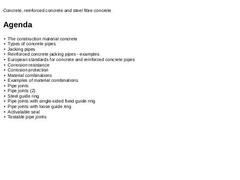
|

|
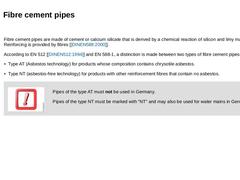
|
Fibre cement pipes are made of cement or calcium silicate that is derived by a chemical reaction of silicon and limy materials. Reinforcing is provided by fibres [ [DINEN588:2000]]. According to EN 512 [ [DINEN512:1994]] and EN 588-1, a distinction is made between two types of fibre cement pipes: |
|
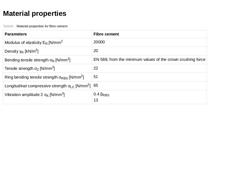
|

(Table: Material properties for fibre cement) |
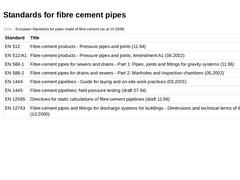
|
(Table: European Standards for pipes made of fibre cement (as at 10.2008)) |
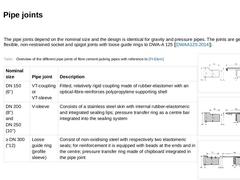
|
The pipe joints depend on the nominal size and the design is identical for gravity and pressure pipes. The joints are generally flexible, non-restrained socket and spigot joints with loose guide rings to DWA-A 125 [ [DWAA125:2014]]. |
|
(Table: Overview of the different pipe joints of fibre cement jacking pipes) |
|
(Image: Fibre cement jacking pipe with VT coupling of rubber elastomeric with poly-propylene support body [FI-Etern]) |
|
(Image: Fibre cement … |
|
|
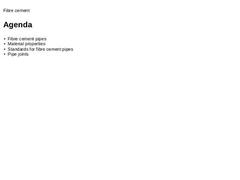
|

|
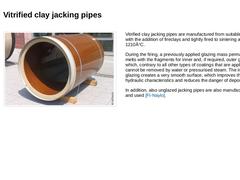
|
|
(Image: Vitrified clay jacking pipe) |
Vitrified clay jacking pipes are manufactured from suitable clays with the addition of fireclays and tightly fired to sintering at 1210°C. During the firing, a previously applied glazing mass permanently melts with the fragments for inner and, if required, outer glazing, which, contrary to all other types of coatings that are applied later, cannot be removed by water or pressurised steam. The internal glazing … |
|
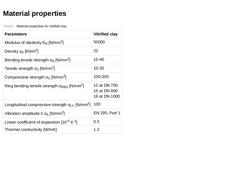
|

(Table: Material properties for vitrified clay) |
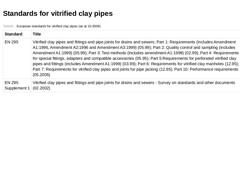
|

(Table: European standards for vitrified clay pipes (as at 10.2008)) |
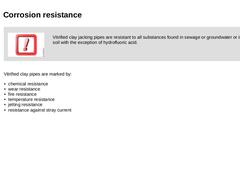
|
|
(Image: Attention!)
Vitrified clay jacking pipes are resistant to all substances found in sewage or groundwater or in the soil with the exception of hydrofluoric acid. |
Vitrified clay pipes are marked by: -
chemical resistance
-
wear resistance
-
fire resistance
-
temperature resistance
-
jetting resistance
-
resistance against stray current
|
|
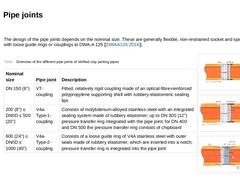
|
The design of the pipe joints depends on the nominal size. These are generally flexible, non-restrained socket and spigot joints with loose guide rings or couplings to DWA-A 125 [ [DWAA125:2014]]. |
|
(Table: Overview of the different pipe joints of vitrified clay jacking pipes) |
|
(Image: Vitrified clay jacking pipe DN 150 with glass fibre reinforced polypropylene coupling [FI-Stein98]) |
|
(Image: Vitrified clay jacking pipe DN 200 to DN 500 with V4A … |
|
|
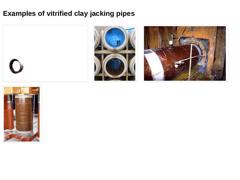
|

(Image: Examples for jacking pipes made of various materials - Vitrified clay [FI-Steinb]) (Image: Vitrified clay jacking pipes) (Image: Jacking of a vitrified clay pipe in microtunneling ) (Image: Pressure test on a vitrified clay jacking pipe) |
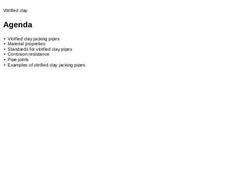
|

|
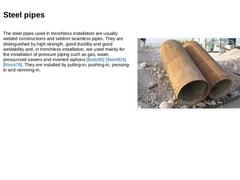
|
The steel pipes used in trenchless installation are usually welded constructions and seldom seamless pipes. They are distinguished by high strength, good ductility and good weldability and, in trenchless installation, are used mainly for the installation of pressure piping such as gas, water, pressurized sewers and inverted siphons [Buttc85] [Stein82b] [Rinck79]. They are installed by pulling-in, pushing-in, pressing-in and ramming-in. |
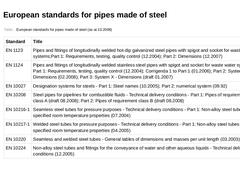
|
|
(Table: European standards for pipes made of steel (as at 10.2008)) |
|
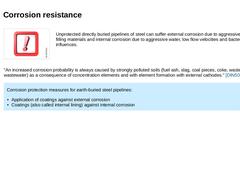
|
|
(Image: Attention!)
Unprotected directly buried pipelines of steel can suffer external corrosion due to aggressive soils or filling materials and internal corrosion due to aggressive water, low flow velocities and bacterial influences. |
|
"An increased corrosion probability is always caused by strongly polluted soils (fuel ash, slag, coal pieces, coke, waste, rubble, wastewater) as a consequence of concentration elements and with element formation … |
|
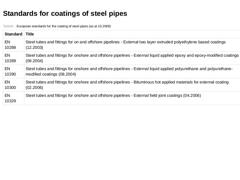
|

(Table: European standards for the coating of steel pipes (as at 10.2008)) |

|

| (Image: Casing pipes [FI-Steina]) | Casing pipes:
It can be dispensed with external protection if the product pipe installed inside is self-bearing and the annular space is completely filled or an oxidation allowance was made to the wall thickness. |
| | (Image: Bundled installation inside the host pipe [FI-Steina]) | Host pipes:
Here correspondingly, the descriptions regarding casing pipes apply. |
| | (Image: Product pipes [FI-Steina]) | Product pipes:
The … |
|
|
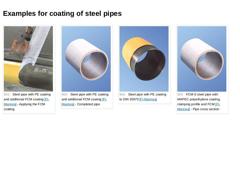
|

(Image: Steel pipe with PE coating and additional FCM coating [FI-Mannea] - Applying the FCM coating) (Image: Steel pipe with PE coating and additional FCM coating [FI-Mannea] - Completed pipe) (Image: Steel pipe with PE coating to DIN 30670 [FI-Mannea]) (Image: FCM-S steel pipe with MAPEC polyethylene coating, clamping profile and FCM [FI-Mannea] - Pipe cross section) |
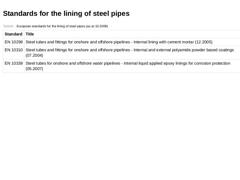
|

(Table: European standards for the lining of steel pipes (as at 10.2008)) |
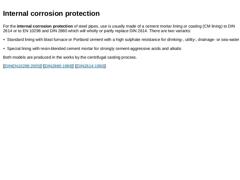
|

For the internal corrosion protection of steel pipes, use is usually made of a cement mortar lining or coating (CM lining) to DIN 2614 or to EN 10298 and DIN 2880 which will wholly or partly replace DIN 2614. There are two variants: -
Standard lining with blast furnace or Portland cement with a high sulphate resistance for drinking-, utility-, drainage- or sea-water
-
Special lining with resin-blended cement mortar for strongly cement-aggressive acids …
|
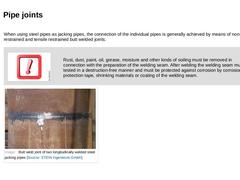
|
|
When using steel pipes as jacking pipes, the connection of the individual pipes is generally achieved by means of non-restrained and tensile restrained butt welded joints. |
|
(Image: Attention!) |
Rust, dust, paint, oil, grease, moisture and other kinds of soiling must be removed in connection with the preparation of the welding seam. After welding the welding seam must be tested in a destruction-free manner and must be protected against corrosion … |
|
|
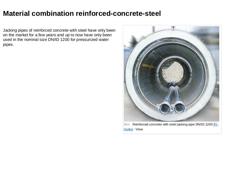
|

Jacking pipes of reinforced concrete with steel have only been on the market for a few years and up to now have only been used in the nominal size DN/ID 1200 for pressurized water pipes. (Image: Reinforced concrete with steel jacking pipe DN/ID 1200 [FI-Gollw] - View) |

|

|
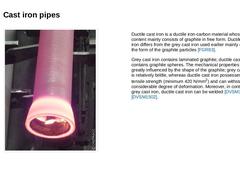
|
|
(Image: Production of a cast iron pipe) |
Ductile cast iron is a ductile iron-carbon material whose carbon content mainly consists of graphite in free form. Ductile cast iron differs from the grey cast iron used earlier mainly due to the form of the graphite particles [FGR83]. Grey cast iron contains laminated graphite; ductile cast iron contains graphite spheres. The mechanical properties are greatly influenced by the shape of the graphite; grey … |
|